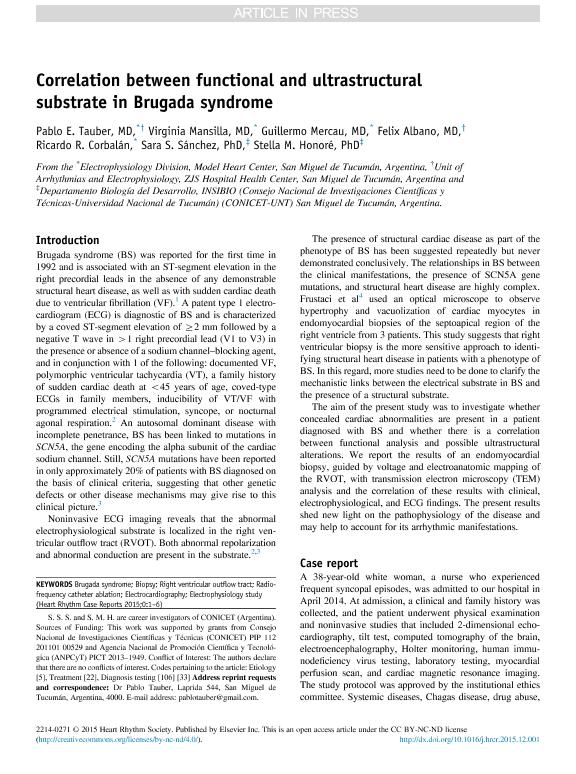Artículo
Correlation between functional and ultrastructural substrate in Brugada syndrome
Tauber, Pablo E.; Mansilla, Virginia; Mercau Torres, Guillermo Adolfo; Albano, Félix; Corbalán, Ricardo R.; Sanchez, Sara Serafina del V. ; Honore, Stella Maris
; Honore, Stella Maris
 ; Honore, Stella Maris
; Honore, Stella Maris
Fecha de publicación:
05/2016
Editorial:
Elsevier
Revista:
HeartRhythm Case Reports
ISSN:
2214-0271
Idioma:
Inglés
Tipo de recurso:
Artículo publicado
Clasificación temática:
Resumen
Brugada syndrome (BS) was reported for the first time in 1992 and is associated with an ST-segment elevation in the right precordial leads in the absence of any demonstrable structural heart disease, as well as with sudden cardiac death due to ventricular fibrillation (VF).1 A patent type 1 electrocardiogram (ECG) is diagnostic of BS and is characterized by a coved ST-segment elevation of ≥2 mm followed by a negative T wave in >1 right precordial lead (V1 to V3) in the presence or absence of a sodium channel–blocking agent, and in conjunction with 1 of the following: documented VF, polymorphic ventricular tachycardia (VT), a family history of sudden cardiac death at <45 years of age, coved-type ECGs in family members, inducibility of VT/VF with programmed electrical stimulation, syncope, or nocturnal agonal respiration.2 An autosomal dominant disease with incomplete penetrance, BS has been linked to mutations in SCN5A, the gene encoding the alpha subunit of the cardiac sodium channel. Still, SCN5A mutations have been reported in only approximately 20% of patients with BS diagnosed on the basis of clinical criteria, suggesting that other genetic defects or other disease mechanisms may give rise to this clinical picture.
Palabras clave:
Brugada Syndrome
,
Heart Disease
,
Ventricular Fibrillation
Archivos asociados
Licencia
Identificadores
Colecciones
Articulos(INSIBIO)
Articulos de INST.SUP.DE INVEST.BIOLOGICAS
Articulos de INST.SUP.DE INVEST.BIOLOGICAS
Citación
Tauber, Pablo E.; Mansilla, Virginia; Mercau Torres, Guillermo Adolfo; Albano, Félix; Corbalán, Ricardo R.; et al.; Correlation between functional and ultrastructural substrate in Brugada syndrome; Elsevier; HeartRhythm Case Reports; 2; 3; 5-2016; 211-216
Compartir
Altmétricas



